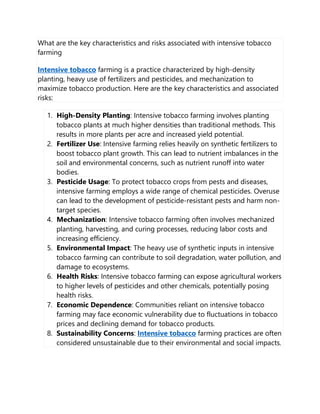intensive tobacco .pdf
•
0 likes•4 views
Intensive tobacco farming is a high-yield agricultural approach characterized by dense planting, heavy use of fertilizers and pesticides, mechanization, and potential environmental and health concerns due to intensive resource utilization.
Report
Share
Report
Share
Download to read offline

Recommended
Environmental and health implications of chemical fertilizers and pesticides
Environmental and health implications of chemical fertilizers and pesticides

Environmental and health implications of chemical fertilizers and pesticidesKottakkal farook arts and science college
Recommended
Environmental and health implications of chemical fertilizers and pesticides
Environmental and health implications of chemical fertilizers and pesticides

Environmental and health implications of chemical fertilizers and pesticidesKottakkal farook arts and science college
More Related Content
Similar to intensive tobacco .pdf
Similar to intensive tobacco .pdf (20)
4. integrated weed management methods A Lecture by Allah Dad Khan 

4. integrated weed management methods A Lecture by Allah Dad Khan
19. .integrated weed management (weed management methods) A Presentation By...

19. .integrated weed management (weed management methods) A Presentation By...
Horticultural production: Causing land degradation or enhancing resilience?

Horticultural production: Causing land degradation or enhancing resilience?
An Overview of Sustainable Fertilizer Developments.pdf

An Overview of Sustainable Fertilizer Developments.pdf
Biodynamic agriculture, organic farming, biopestisides by Pooja Khanpara

Biodynamic agriculture, organic farming, biopestisides by Pooja Khanpara
Traditional, Alternative & Solar Drying methods for producing spices: A Review

Traditional, Alternative & Solar Drying methods for producing spices: A Review
The growing Demand for Essential Oils for Agricultural Applications

The growing Demand for Essential Oils for Agricultural Applications
intensive tobacco .pdf
- 1. What are the key characteristics and risks associated with intensive tobacco farming Intensive tobacco farming is a practice characterized by high-density planting, heavy use of fertilizers and pesticides, and mechanization to maximize tobacco production. Here are the key characteristics and associated risks: 1. High-Density Planting: Intensive tobacco farming involves planting tobacco plants at much higher densities than traditional methods. This results in more plants per acre and increased yield potential. 2. Fertilizer Use: Intensive farming relies heavily on synthetic fertilizers to boost tobacco plant growth. This can lead to nutrient imbalances in the soil and environmental concerns, such as nutrient runoff into water bodies. 3. Pesticide Usage: To protect tobacco crops from pests and diseases, intensive farming employs a wide range of chemical pesticides. Overuse can lead to the development of pesticide-resistant pests and harm non- target species. 4. Mechanization: Intensive tobacco farming often involves mechanized planting, harvesting, and curing processes, reducing labor costs and increasing efficiency. 5. Environmental Impact: The heavy use of synthetic inputs in intensive tobacco farming can contribute to soil degradation, water pollution, and damage to ecosystems. 6. Health Risks: Intensive tobacco farming can expose agricultural workers to higher levels of pesticides and other chemicals, potentially posing health risks. 7. Economic Dependence: Communities reliant on intensive tobacco farming may face economic vulnerability due to fluctuations in tobacco prices and declining demand for tobacco products. 8. Sustainability Concerns: Intensive tobacco farming practices are often considered unsustainable due to their environmental and social impacts.
- 2. To address these concerns, sustainable and responsible farming practices, including crop rotation, reduced pesticide use, and soil conservation techniques, are being encouraged within the tobacco industry. Additionally, diversifying agricultural activities in tobacco-dependent regions can help mitigate economic risks associated with intensive tobacco farming.